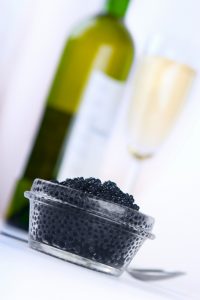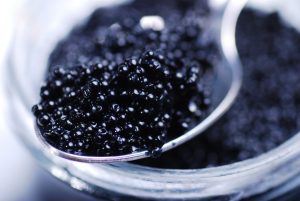Beluga
Our Caviar is the beluga caviar consisting of the roe (or eggs) of the beluga sturgeon Huso huso. The fish is found primarily in the Caspian Sea, which is bordered by Iran, Azerbaijan, Kazakhstan, Russia, and Turkmenistan. It can also be found in the Black Sea basin and occasionally in the Adriatic Sea.
The beluga sturgeon can take up to 20 years to reach maturity. The fish harvested for caviar are often nearly 900 kg (2,000 lb). The eggs themselves are the largest of the commonly used roes, and range in colour from dark grey (almost black) to light grey, with the lighter colours coming from older fish, and being the most valued.
The rarest caviar is “Almas”, a golden caviar produced by very rare female albino sturgeon between 60 and 100 years old, which swims in the southern Caspian Sea near Iran. Very few of the albino variety are left in the wild since the lack of melanin is a genetic disorder that only affects a few members of the species.

Any additions by producers diminish the value of the roe, and the caviar usually reaches the market without any additions or processing whatsoever.
As with most caviars, beluga is us
ually handled with a caviar spoon made of mother of pearl, bone, or other non-metallic material, as metal utensils are said to impart an unwelcome metallic taste to the delicate roe. Beluga caviar is usually served by itself on toast, unlike other less expensive caviars that can be served in a variety of ways, including hollowed and cooked new potatoes, on a blini, or garnished with sour cream, creme fraiche, chopped onions, or minced hardboiled egg whites. These items can, however, be served with beluga as palate cleansers.
Besides being a delicacy, it’s highly nutritious, providing great amounts of omega-3 fatty acids, vitamin B12, and selenium, among other vitamins and minerals — even in small serving sizes.
If you’re looking for an excuse to eat caviar occasionally, you’ll be pleased to know that it may benefit the health of your skin, brain, heart, and immune system.
“Under the law of the United Kingdom, sturgeons are royal fish, and when taken become the personal property of Her Majesty The Queen as part of her royal prerogative.”


